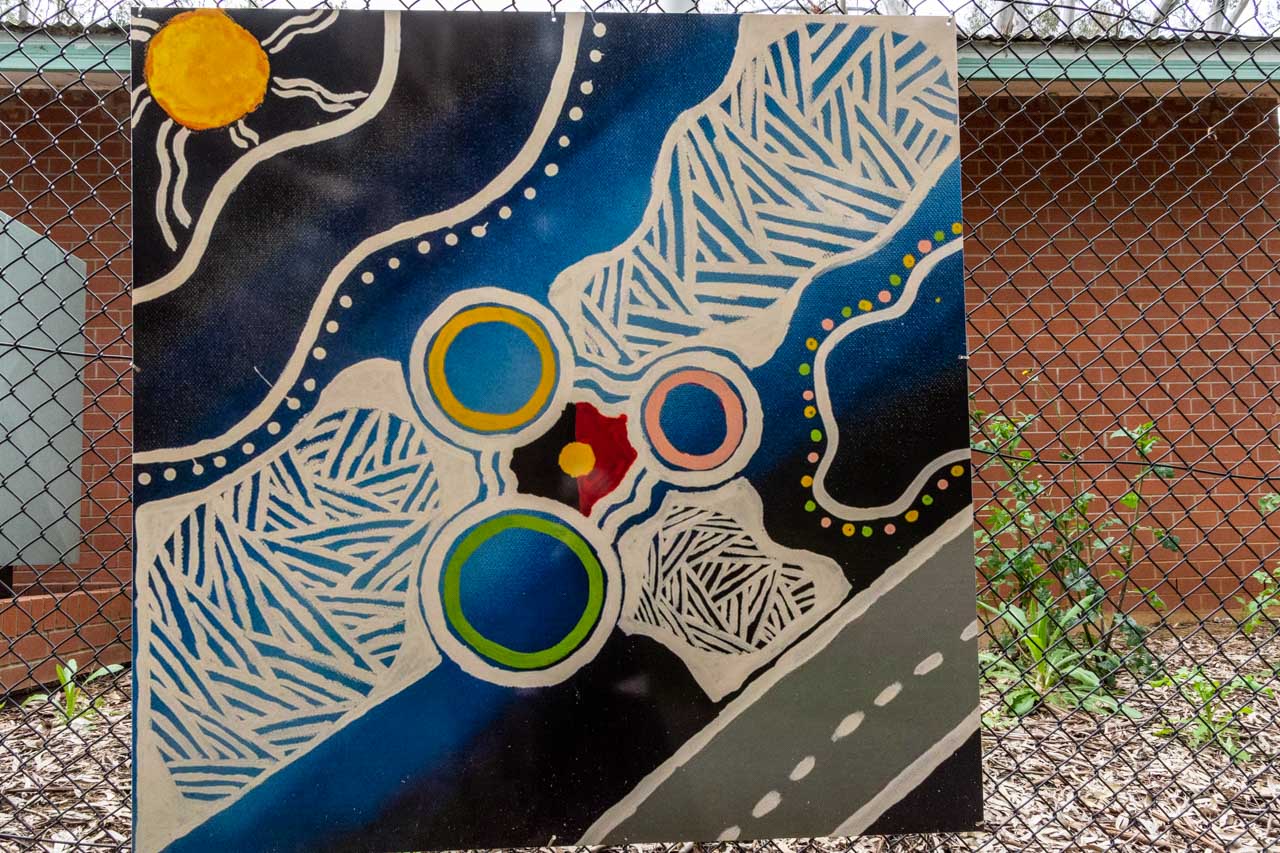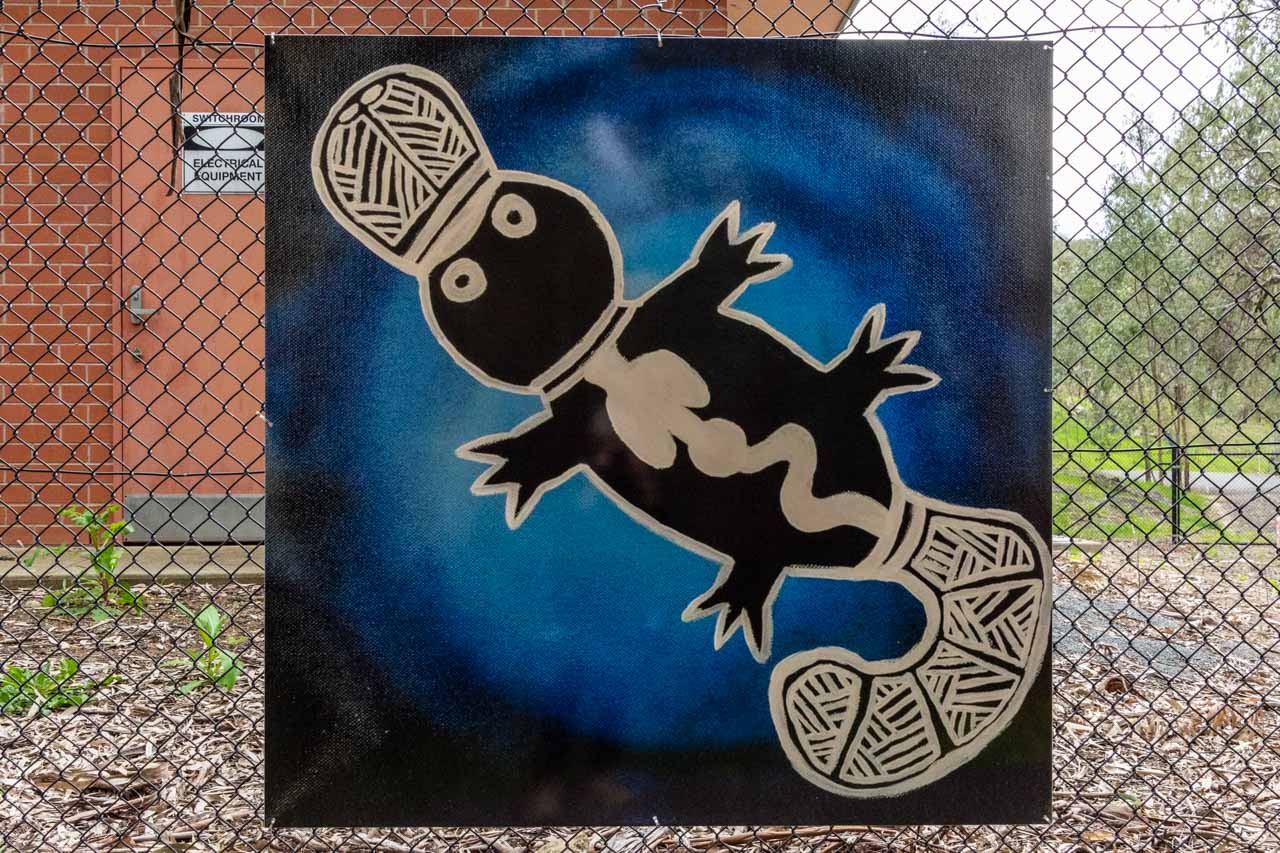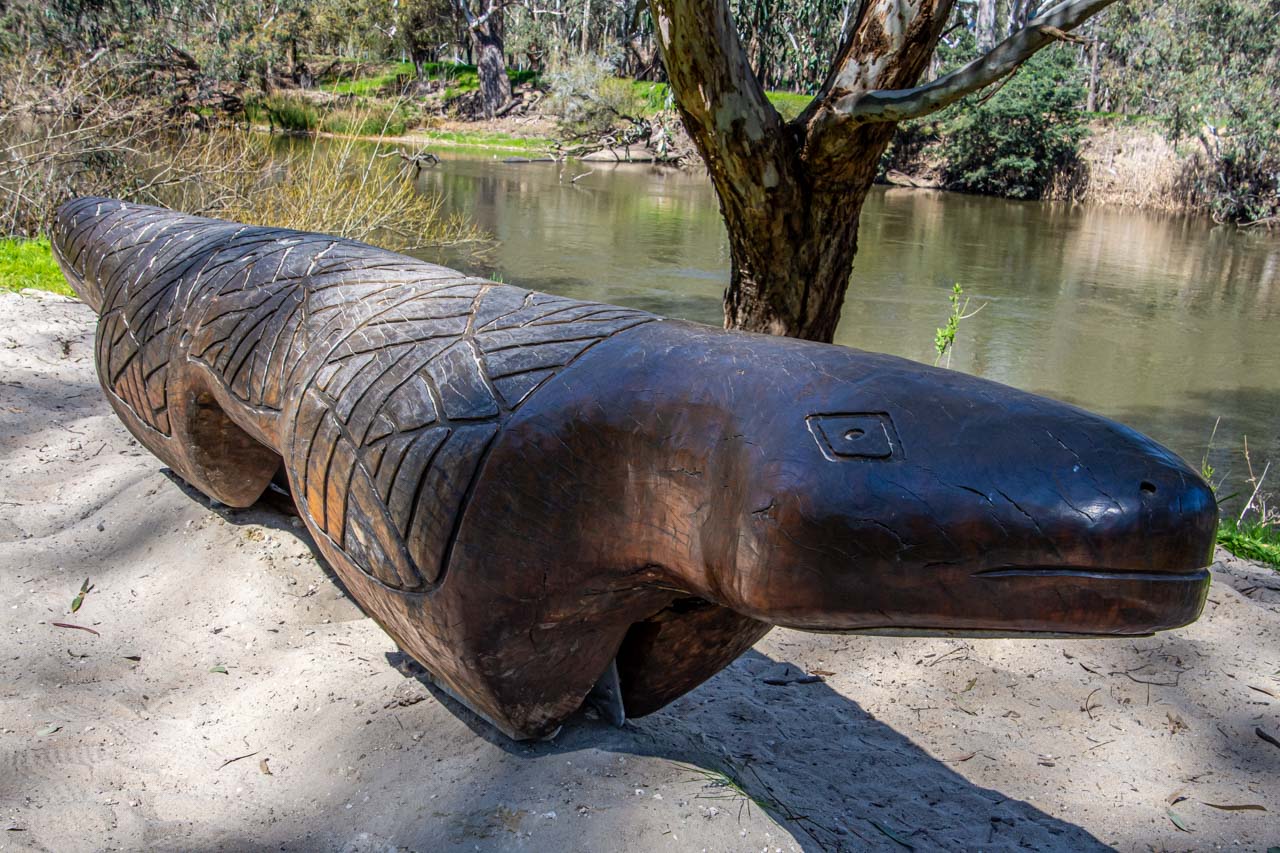Unique Sculptures Beside the Murray River in Albury Celebrate Local Aboriginal Art and Culture The Yindyamarra Sculpture Walk is a shared walking and cycling path with the mighty Murray…
Unique Sculptures Beside the Murray River in Albury Celebrate Local Aboriginal Art and Culture
The Yindyamarra Sculpture Walk is a shared walking and cycling path with the mighty Murray River on one side and West Albury Wetlands on the other. What makes this path unique is the Aboriginal sculptures by local Indigenous artists installed along the way, sculptures that tell stories of Aboriginal culture and lore. Follow the Yindyamarra Sculpture Walk through the photographs in this post, learning about each sculpture as you go.
The Yindyamarra Sculpture Walk in Albury is a 5.6-kilometre (loop) section of the much longer Wagirra Trail (15 kilometres return, linking Wonga Wetlands with the South Albury Trail). Following the Murray River, the Yindyamarra Sculpture Walk stretches from the Kremur Street boat ramp (off Padman Drive in West Albury) to Horseshoe Lagoon (accessed via the Riverina Highway). You can do the walk in the reverse direction.
I first published THE UNIQUE YINDYAMARRA SCULPTURE WALK IN ALBURY, NEW SOUTH WALES on November 22, 2020. At the time, Albury City Council had announced three new sculptures would be installed in July 2021. So, I knew I would be updating this post within the year.
The first stage of the Yindyamarra Sculpture Walk was completed in December 2014. In July 2021, three new sculptures were added to the trail, and ten painted panels (‘Leaving Our Mark’) were installed along two fences near Horseshoe Lagoon. The contemporary artwork along the Yindyamarra Sculpture Walk has been created by local Indigenous artists telling stories of connection to country and living culture. The sculptures are a celebration of local Aboriginal culture.
Bicycle riders, walkers, and joggers share the predominantly flat, 2-metre-wide sealed path. Dogs on leads are permitted.
Albury, on the New South Wales side of the Murray River (Australia’s longest river), is located in Wiradjuri Country – the traditional lands of the Aboriginal Wiradjuri people.
Yindyamarra is a word from the Wiradjuri language, meaning respect, be gentle, be polite, and do slowly.
I have walked the Yindyamarra Sculpture Walk several times. Refer to the end of this post to know the lessons I have learned from walking the Yindyamarra Sculpture Walk.
The Sculptures:
The information provided below about the artists and the story behind the sculptures is taken from the interpretive panels presented at each sculpture site.
Starting the Yindyamarra Sculpture Walk from the Kremur Street Boat Ramp, I will take you on a visual tour of unique Aboriginal art by Indigenous artists along the banks of the Murray River in Albury. I aim to pique your interest enough for you to walk or ride this beautiful path for yourself.
Teaming Life of Milawa Billa
Artists: Teaming Life of Milawa Billa (Murray River) was created by the Yindyamarra Sculpture Walk Steering Committee – Daniel Cledd, Robyn Heckenberg, John Murray, Aunty Edna Stewart, and Aunty Muriel Williams.
The Teaming Life of Milawa Billa sculpture signals the commencement of the Yindyamarra Sculpture Walk at the Kremur Street Boat Ramp picnic area. The design draws together significant elements from the natural environment of the Murray River – the birds, the fish, the reeds, and the yabby – telling the story of the health of the river and its cultural significance.
Reconciliation Shield
Artist: Tamara Murray. Tamara is a proud member of the Barkandtji tribe on her mother’s side and Yorta Yorta and Dhudaroah tribes on her father’s side.
For Tamara, the Reconciliation Shield represents bringing everyone together – working together, walking together, and living together; to make everything better, especially for the next generation. ‘The figure depicted is holding his hands in a position of submission. Enough is enough – we all need to walk together on this journey of reconciliation.’
Creature Seats
Artists: James Fallon High School. The standing goanna by Liam Campbell (Wiradjuri), the turtle by Sara Jackson Edwards (Wamba Wamba), the snake by Raymond Jackson Edwards (Wamba Wamba), and the climbing goanna by Jaidyon Hampton (Malyangaba).
The students sculpted these creatures under the mentorship of the Aboriginal Men’s Shed and the local community. The students created a space where stories could be told and local animal life could be celebrated.
Guguburra
Artist: Peter Ingram. Peter is a local Wiradjuri man who enjoys making sculptures from metal and many other resources, creating artworks that bring to life country’s ancient stories of creation and lore.
Guguburra is the Wiradjuri word for kookaburra. It is seen as the most beautiful bird (budyaan) in Wiradjuri country, with wonderful attributes and character.
Guruburra is patient and kind. He will often let others before him but will defend his ground if required. He loves to laugh and reminds us to do so each day. He travels in family groups, is loyal, but sometimes ventures out alone to visit a friend and sing them a beautiful song. Guruburra shows us a wonderful way to live our lives – with joy, balance, and patience.
Vertical Message Sticks
Artist: Carmel Taylor. Carmel is a Wiradjuri woman.
The message sticks are a celebration of Carmel’s knowledge of the natural history of the river.
Carmel tells us she chose the theme of animals because she genuinely loves them, and they are native to the Albury area, bringing much joy to children and adults.
Bogong Moth Migration
Artist: Ruth Davys. Ruth is a proud Wiradjuri woman.
The Bogong Moth is a creature of cultural significance for Indigenous Australians.
Traditionally, each year the Indigenous people of southern New South Wales and northern Victoria would meet at Mungabareena Reserve (Albury) to perform ceremonies, exchange goods and discuss tribal lore. They would then travel to the high country (Victoria’s Alpine region) to feast on Bogong Moths.
Family Gathering
Artist: Michael Quinn. Michael is a locally based Wiradjuri man. Family is very important to Michael. They are his life.
Michael’s sculpture depicts how the family used to gather and represents the importance of the family group – their staying together and connection to the land. The circle represents this unity, and the rocks represent strength and the earth. Thereby, holding the group together.
Celebrate Together
Walk with us on Wiradjuri Country
Artist: Tamara Murray. Tamara is a proud member of the Barkandtji tribe on her mother’s side, and Yorta Yorta and Dhudaroah tribes on her father’s side. Having lived on Wiradjuri land for 14 years, Tamara tells us her spirit has never been more at peace than it is on this land.
This sculpture sends a strong message to all that we stand, walk and dance on Wiradjuri country. It is a message to Wiradjuri children to hold on to and celebrate their culture as their ancestors have done and are still doing.
The Bigger Picture
Artist: Katrina Weston. Katrina is an Aboriginal person from the Barkindtji/Nyampa tribes.
According to Katrina, the purpose of the oversized picture frame is to see how the landscape changes within the frame over the years to come.
The picture within the frame is a moving, living landscape with many stories to be told and shared. It will bring people together to share traditional stories. The picture frame represents movement and change for Aboriginal people who are evolving to adapt to the ever-changing environment.
Leaving Our Mark
Artists: Various members of Albury City’s Wagirra Team – Curtis Reid, Jarret Trewin, Harry Dennis, Leroy Eggmolesse, Shane Charles, Noel Stewart, Ethan Moffitt, Richard Sievers, Keanu Wighton, and Toby Ardler.
Working on the Wagirra trail, a section of which is the Yindyamarra Sculpture Walk, connected the artists to country and culture. The images are their way of telling their story along the trail.
Goanna
Artist: Kianna Edwards. Kianna is a young Wiradjuri woman from Albury.
Kianna comments, “This Goanna represents one of the main totems for the Wiradjuri Nation. It holds a significant place in my spirit. It’s my totem. My story. My culture.”
‘Maya’ Fish Trap
Artists: Uncle Ken (Tunny) Murray, Darren Wighton and Andom Rendell from the Aboriginal Men’s Shed.
This over-proportioned sculpture is of a funnel style fish trap that was commonly used by the Wiradjuri people in the Albury area. These traps were woven from reeds and could even be customised to trap specific fish as well as allowing smaller fish to escape, thus protecting the species for the future.
Wiradjuri Woman
Artist: Leonie McIntosh. Leonie is a proud Wiradjuri woman.
Leonie’s Wiradjuri Woman sculpture is based on the Possum Skin Cloak design burnt on her Nan’s cloak, which she wore for the opening ceremony of the Melbourne Commonwealth Games in 2006.
Leonie has created a sculpture of Wiradjuri Woman emerging out of this 350 – 400-year-old tree stump – ‘as if a spirit is breaking free’.
Googar
Artist: Darren Wighton. Darren is a community leader of Wiradjuri descent.
‘Googar’ is the Wiradjuri word for ‘goanna’. At 4 metres in length, Darren’s Googar sculpture is a larger-than-life version of a small wooden toy goanna that Wiradjuri children would play with and learn from in traditional times.
Useful information
At the Kremur Street boat ramp, you will find free parking, public toilets, and a picnic area.
Horseshoe Lagoon has parking off the Riverina Highway but has no toilets or picnic facilities. It is a couple of minutes walk from the parking area to join the Yindyamarra Sculpture Walk trail.
Albury is a large inland city in New South Wales on the banks of the Murray River – Australia’s longest river. It is 553 kilometres southwest of Sydney via the Hume Highway and 326 kilometres northeast of Melbourne.
Lessons learned from having walked the Yindyamarra Sculpture Walk previously:
The first time I walked the Yindyamarra Sculpture Walk was with my sister. We commenced our walk at Noreuil Park and walked to Wonga Wetlands. As the car was at Noreuil Park, we had no alternative but to walk back the way we had come. This walk was a 14-kilometre round trip. By the time we were halfway back on our return journey, we could barely lift our feet and couldn’t talk to each other.
My second attempt at the Yindyamarra Sculpture Walk was with my daughter. We left the car at Noreuil Park (I must be a slow learner) and headed out on the walk. About a kilometre from Wonga Wetlands (6 kilometres walked), my daughter could see I was flagging. So, as you can imagine, I jumped at her suggestion to sit in the shade of a tree while she jogged back for the car. Oh, to be young and fit!
My third walk along the Yindyamarra Sculpture Walk was with two friends. I insisted we have a car at either end of the walk as I had now (finally) learned my walking limitations. On this occasion, we left a car at the Kremur Street Boat Ramp and drove to Wonga Wetlands, where we left the second car and commenced our walk.
When I initially wrote this article (November 2020), I recommended readers to walk between Horseshoe Lagoon and Kremur Street Boat Ramp (or vice versa), with a car at either end. It would seem, in the pursuing months, I have become fitter. On my latest venture along the Yindyamarra Sculpture Walk to take photos of the additional sculptures, I found the 5.6-kilometre loop an easy, enjoyable walk.
What my friends had to say about the Yindyamarra Sculpture Walk:
For those bird lovers out there, one of my friends recommends taking binoculars as there are several species of birds to spot along the walk.
Both friends thoroughly enjoyed the walk (described as a ‘leisurely stroll’ by one), and they commented on the number of birds, wildlife and plants seen along the way. As one friend said, seating along the walk would have been good – to absorb a sculpture, to sit and watch the river flow past, and to contemplate the landscape.
I have walked the Yindyamarra Sculpture Walk several times now and have not tired of seeing the sculptures. My friends felt the sculptures showcased the artistic abilities of the local men and women of the surrounding indigenous tribes while telling their own unique stories.
I, my friends, my daughter, and my sister, recommend the Yindyamarra Sculpture Walk. With the sculptures, the river, and the surrounding bush, it is an exceptional, unique walk. Ride your bike, walk the dog, or not, but see the sculptures for yourself.
Editor’s Note: This post was originally published in November 2020 and has been updated for accuracy and comprehensiveness.
Disclaimer: This post contains no affiliate links. All views and opinions are my own and non-sponsored. All photos are my own and remain the copyright of Just Me Travel 2021.
Comment below to share your thoughts on this blog post. Where else have you seen Aboriginal sculptures that you would like to share with readers?
Like this post? PIN it!
Related posts
Still on an art theme in Australia, check out the posts below I wrote on the unique silo art in Victoria and New South Wales. They are packed with amazing photos, information, and tips.
> The Complete Guide to Road Tripping Victoria’s Silo Art Trail
> Unique Silo Art Celebrates Local Communities and Fauna
> 3 of the Best Things to See and Do in Rochester
> 5 of the Best Painted Silos in New South Wales
Author’s Note: Please check the latest travel restrictions before planning any trip, and always follow government advice.
Copyright © Just Me Travel 2021. All rights reserved.

































